



Kolyma Kennels
Europese Pioniers - European Pioneers
De pioniers van de sledehonden sport en het ras in Europa zal je op deze bladzijden tegenkomen. Ook hier bepaal ik me tot de periode 1965-1975 en - ook hier - niet specifiek in chronologische volgorde. In de verdere ontwikkeling van deze website zal er vaak alsnog informatie toegevoegd gaan worden over de mushers en kennels die je er nu al aantreft maar ook informatie over mushers waarvan ik geen informatie in mijn eigen files heb, maar waaraan ik vanaf nu zal gaan werken om dit zo compleet mogelijk te krijgen.
On this page you will find the pioneers of sled-dog sport and the breed in Europe. I am focusing here on the period 1965-1975, but not specifically in chronological order. As the website continues to develop additional information will be added, not only about the teams already detailed, but also several teams and mushers for whom I have no information available in my own files, but will work on to make the information as complete as possible.
Thomas Althaus (Zwitserland) heeft aan het begin gestaan van de sleehondensport in Centraal Europa. Hij organiseerde het eerste sledehondenkamp in Engelberg, Zwitserland. Hij is een zeer bekend FCI Keurmeester (allround, voor alle rassen) geworden.
Thomas Althaus (Switzerland) got the sled-dog sport in Central Europe started by organizing the first sled-dog camp in Engelberg, Switzerland. He became very well known as an FCI Judge (for all breeds).
Ernst Müller (Zwitserland) heeft een grote invloed gehad op de Europese sleehondensport, hij was de eerste professional musher. De Klondike shop bestaat nog steeds en Ernst heeft als prominent lid van ISDRA en ESDRA (International/European Sled Dog Race Association), de Europese sleehondensport universeel erkend gekregen.
Edi Habegger (Zwitserland) heeft lang wedstrijden gelopen op de Europese trails. Hij fokte Mikkisok Tyrianiak met zijn teefje uit de fokkerij van Thomas Althaus’ Monadnock bloedlijn. Het resultaat was spectaculair. Edi heeft het hele nest gehouden en er een zeer competitief team van gemaakt. Hier zijn eerste team in Unteriberg 1974.
Edi Habegger (Switzerland) had been racing on the European trails for a long time. He bred Mikisok Tyrianiak to his female out of Thomas Althaus’ Monadnock bloodline. The result was a spectacular litter which Edi kept and build into a very competitive team. The photo here is of his first team in Unteriberg in 1974.
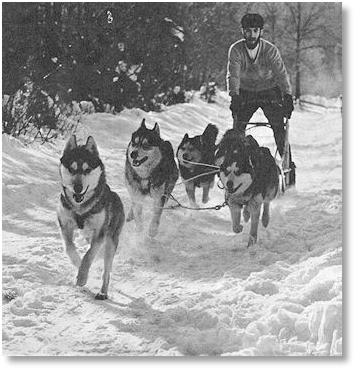
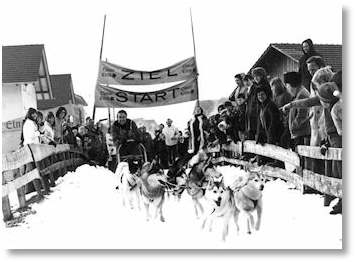

Ernst Müller (Switzerland) had a great impact on the European sled-dog sport, becoming the first full professional. The Klondike shop still exists and Ernst was a prominent member of ISDRA and ESDRA (International/European Sled Dog Race Association), getting European sled-dog racing universally recognized.
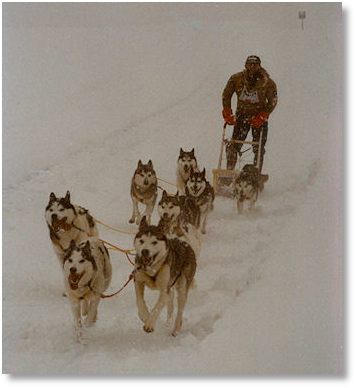
Peter Thomann (Zwitserland) zijn entree in de sport en de Europese wedstrijd scene was stormachtig. Hij had een erg goed team. Hij fokte Kaltag of Kolyma, zijn nestkeuze uit ons nest uit Vanessa of Kolyma x Alaskan’s Pala of Anadyr, had een enorme storm tot gevolg omdat Kaltag monorchide (één teelbal) had en de Zwitserse Kennelclub het verbood deze honden te fokken Dus geen officiële AKC stambomen voor Kaltags nazaten. In een later stadium constateerden dierenartsen dat zijn 2e teelbal vergenoeg was ingedaald om de toekenning van officiële stambomen voor deze nazaten alsnog toe te kennen. En dat is gecorrigeerd geworden. Pala was een hond uit Earl Norris’ eerste team (de pinto in lead op beide foto), dus waarom hij besloot Kaltag te fokken (de grijze hond in lead kleurenfoto) terwijl hij Pala in bezit had, hebben we nooit begrepen. Peter Thomann is uiteindelijk met al zijn honden naar Alaska geëmigreerd.
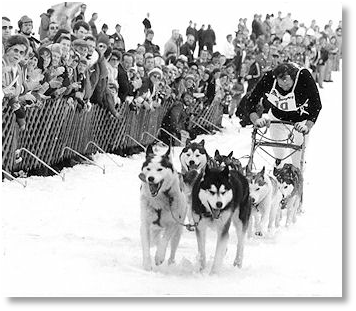
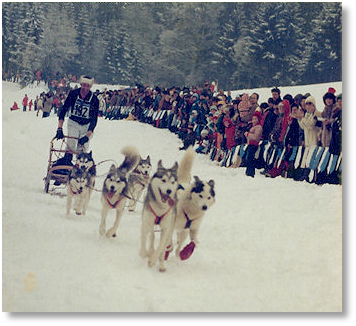
Joseph “Sepp” Felder (Switzerland) was one of the true pioneers of the sport and a very energetic and vital senior who participated in the Open Races without any problem. And with good success. This is the only picture I have of him. In his team were dogs bred by himself out of Thomas Althaus’ Kamchatka breeding stock (Monadnock). Sepp started out with Samoyeds but switched to Siberian Huskies for racing.
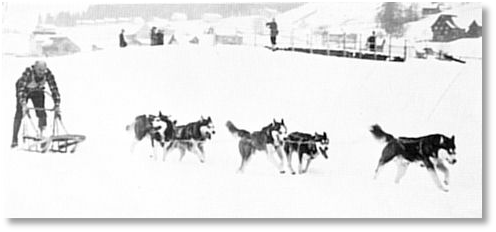
Joseph “Sepp” Felder (Zwitserland) was een van de echte pioniers in de sport en een uitermate vitale senior die zonder moeite aan de Open Wedstrijden deelnam. En goed ook! Dit is de enige foto die ik van hem heb. In zijn team de door hemzelf gefokte honden met afstamming van Thomas Althaus’ Kamchatka’s (Monadnock). In oorsprong had hij Samojeden, maar schakelde toch over naar de Siberian Huskies voor de wedstrijdsport.
Grethe Westring (Denemarken) is de absolute pionier in Denemarken en Centraal Europa voor de Siberian Husky. In eerste lijn had ze uitsluitend absoluut witte honden die in haar fokkerij overwegend witte honden doorgaven. Maar langzamerhand begonnen er ook grijze en zwart witte honden uit te vallen. We hadden al snel contact samen, maar Denemarken had in die eerste jaren nog de quarantaine restricties voor honden en katten wat interactie op dat gebied niet makkelijk maakte. Grethe was op haar eenvoudige manier al bezig het ras ook als werkende sleehond te promoten. Ze kreeg veel publiciteit in kranten en tijdschriften. Ook op de tentoonstellingen zette ze haar honden voor een klein karretje als demonstratie en daar trok ze de aandacht van Axel Vermehren (Yokon Kennels) die zijn eerste honden van haar kocht. Gelukkig was Denemarken het eerste land wat de quarantaine als snel ophief – Zweden, Finland en Noorwegen volgden kort daarna – en zo kon Axel met zijn team in opbouw aan de wedstrijden in Centraal Europa deelnemen.
Grethe gebruikte onze Ch. Alaskan’s Babiche of Anadyr voor de fok voor haar basisteefje Ch. Allerelli’s Candy en ook Babiches zoon Green Berets Snowy Arctic. Ik importeerde Alaskan’s Kaltag of Anadyr (Seppala van moeders kant) voor haar die ze Kampioen showde en die als ervaren wat oudere getrainde sleehond haar teampje aan de gang hield en in haar fok goede honden gaf. Vele van haar fokproducten kwamen bij Deense mushers in hun teams terecht en Grethe heeft met deze honden een goede brede genetisch basis gelegd voor het ras in Denemarken.
Grethe Westring (Denmark) was the absolute pioneer in Denmark and Central Europe for the Siberian Husky breed. Initially she had exclusively pure white dogs, which reproduced predominantly that colour when bred, but slowly grey and black & white dogs began to emerge in her litters. We came in contact in those early days, but Denmark still had strict quarantine regulations in place, so interaction with dogs was not easy. However, Grethe really started to promote the Siberian as a working sled dog and generated a lot of publicity on TV and in the press, putting her dogs in front of a small cart and giving demonstrations at dog shows. She soon caught the attention of Axel Vermehren (Yokon Kennels), who bought his first dogs from her. Luckily Denmark was the first Scandinavian country to abolished those quarantine restriction and the other Scandinavian countries followed shortly after, and this enabled the Danish breeders and mushers to participate in the Central European sled dog sport.
Grethe used our Ch. Alaskan’s Babiche of Anadyr for breeding for her first female, Ch. Allerelli’s Candy and later used Babiche’s son Green Berets Snowy Arctic too. I imported the seven year old Alaskan’s Kaltag of Anadyr (Seppala breeding on his Dam’s side) for her, which she showed to his Champions title. Kaltag was an experienced sled dog and helped her little team a lot in her demonstrations and events. She was satisfied with his offspring. Many of the dogs from her breeding program went to Danish mushers and Grethe established a very broad genetic basis for the breed in Denmark.
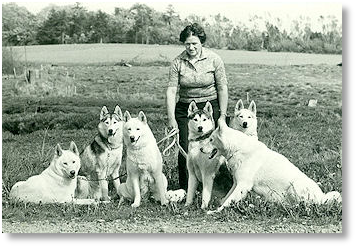
Grethe’s dogs:
Ch. Allerelie’s Candy links, Kaltag 2e links
Ch. Allerelie’s Candy left, Kaltag 2nd left
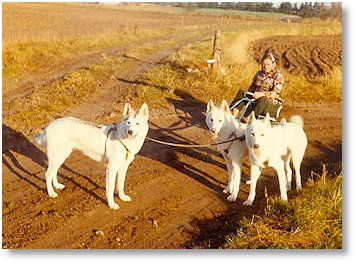
Grethe’s eerste team - Grethe’s first team
Peter Thomann (Switzerland) took the sport and the European race scene by storm in many ways. He ran a very good team. Breeding Kaltag of Kolyma, his stud fee pup out of Alaskan’s Pala of Anadyr and our Vanessa of Kolyma, caused quite an upheaval, as Kaltag was a monorchid (one testicle), which officially was not allowed by the Swiss Kennelclub for breeding. Consequently there were no official AKC pedigrees for Kaltag’s offspring. At a later stage veterinarians concluded that his second testicle had descended low enough in its canal to allow his offspring pedigrees after all, so that was corrected. Pala (the pinto running lead here in the first photo) was a first-string dog in Earl Norris’ team, so why he decided to breed Kaltag (the grey dog running in lead in the colour photo), we never understood. Peter Thomann emigrated to Alaska with all his dogs in the end.
Inger Hedegaard (Denemarken) onjek Kennel kwam uit de dressuur paardensport. Ze is nog steeds keurmeester hiervan, maar was zelf een uitnemend ruiter en maakte deel uit van het Deense Olympische team van Los Angeles op het paard wat zij zelf hiertoe had opgeleid en getraind. Een topprestatie op zich. Inger kwam in aanraking met de Siberische Husky en de wedstrijdsport in Denemarken in 1975 en ging hiermee verder. Ze had een uitzonderlijk inzicht en gevoel voor de fokkerij en het trainen van de honden en al snel liep ze een prachtig zeer competatief 12 honden team op de Centraal Europese wedstrijd trails.
Haar eerste teefje was Finnmarka's Jaki fokker Rose Andersen (Sire en Dam beiden directe afstammelingen van Alaskan’s Astro of Anadyr). Van Chris Camping Kuchin Kennels kocht ze Kuchin Darky (1976). Ze gebruikte Vostok of Kolyma twee keer voor haar fokkerij. Toen wij ophielden met onze kennel gingen onze beste teefjes – Liberty of Kolyma en Emily of Kolyma, samen met Gyp of Kolyma en Zurcko of Kolyma – naar haar toe. Ze hebben het goed gedaan in haar team en fokkerij.
Inger Hedegaard (Denmark) came out of the horse dressage world. She still is a judge in that sport, and was herself an exceptional horsewoman and part of the Danish Olympic team at the Los Angeles Games, participating with a horse she had trained from the beginning of its life, in itself a remarkable achievement. Inger came in contact with the Siberian Husky and the sled-dog sport in Denmark in 1975 and really went for it. She had exceptional insight and feeling for the breeding and training of her dogs, and within a short time she ran a very competitive 12-dog team on the Central European trails.
She started with a female, Finnmarka's Jaki out off Rose Andersen’s litter (with Sire and Dam both going back to Alaskan’s Astro of Anadyr) and imported Kuchin Darky, a male from Chris Camping’s Kuchin Kennels in 1976. She used our Vostok of Kolyma twice for her females and when we closed our kennel we gave our two best females - Liberty of Kolyma and Emily of Kolyma, together with Gyp of Kolyma & Zurcko of Kolyma - to her, from which she bred some very good litters.
Inger mushing haar team op de Bernau trail, 1986
Inger mushing her team on the Bernau trail, 1986
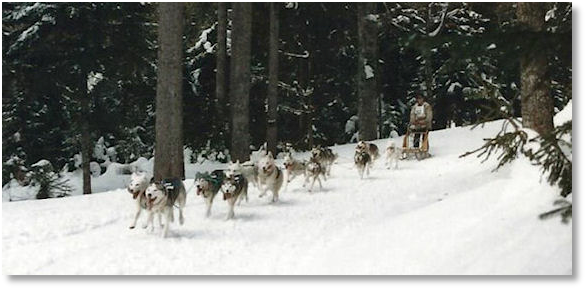
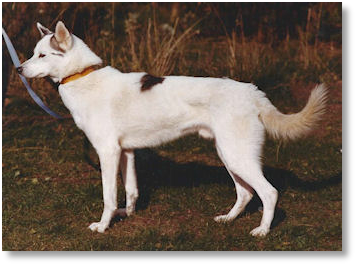
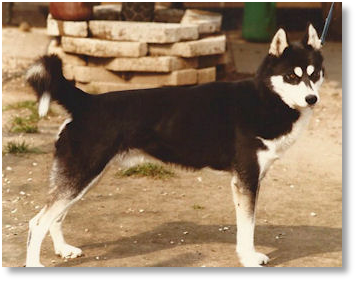
DK. Ch. Donjek Ozelot (Kuchin Darky x Tjep)
Kuchin Darky (Kuchin Suggen x Kuchin Squirrel)



Anneliese Braun (Duitsland) beschouw ik als één van de absolute pioniers van ons ras en de sport in Centraal Europa. Ze heeft baanbrekend werk verricht in haar fokkerij en op de wedstrijdtrails en doet dat nog steeds. Alle informatie over haar honden en de geschiedenis van haar kennel kan je vinden op haar website www.alka-shan.de
Herinner me nog goed dat Lew op een van de wedstrijden met zware sneeuwcondities door Anneliese en haar 12-honden team werd ingehaald en tegen me zei “Tsjonge Els, dat zijn goede allround honden die ze heeft. We konden haar niet bijhouden, ze liep zo van me weg.” Naar aanleiding hiervan hebben we onze fokkerij aangepast qua formaat en schouderhoogte/ruglengte. We hadden dit allround aspect onvoldoende in onze fokkerij in de gaten gehouden.
Anneliese is nog steeds zeer actief in de sport en heeft ook heel goede wedstrijdresultaten geboekt op de Amerikaanse wedstrijdtrails in The Lower 48, zoals de Alaskanen “de rest van de USA noemen” en doet dat nog steeds.
I consider Anneliese Braun (Germany) one of the most important pioneers of our breed and the sport in Central Europe. The way she trained and raced her dogs, as well as her breeding program, was an example to us all, and still is. All information about her dogs and the history of her kennel and racing career can be found on her website www.alka-shan.de
I remember well when Anneliese overtook our team with her 12-dog team on a race with very heavy snow conditions. Lew came back and told me “Wow Els, that is a very good all-round Siberian team she has there. We could not keep up with her, she just overtook and ran away from us.” It proved we had not sufficiently maintained this all-round aspect in our breeding program, and we soon made that correction.
Anneliese still is very active in the sport and did very well on the race trails in The Lower 48, as the Alaskans call “the rest of the USA.”
Anneliese Braun training een
van haar eerste teams
Anneliese Braun training one
of her first teams
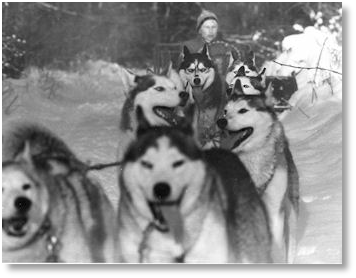
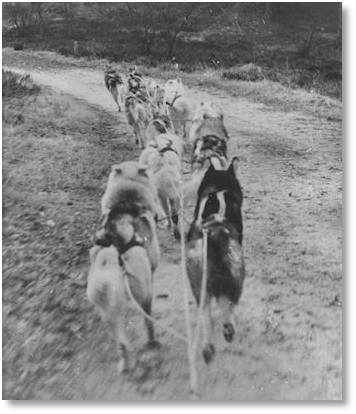
Axel Vermehren (Denemarken) kocht zijn eerste honden van Grethe Westring (Kennel Chuckchi). Liz en Axel namen contact met ons op voor informatie over honden en de training/sport. De quarantaine restrictie was inmiddels opgeheven en zo konden wij ze ook met getrainde honden helpen (Ch. Wobask of Kolyma o.a.). Om meer kleur in de Siberian in Denemarken te scheppen importeerde ik in een later stadium Alaskan’s Funny Face of Anadyr voor hen. Funny Face was een afstammeling aan moeders kant uit de Shango of Seppala lijn. Shango leefde nog toen ik hem zag op de Norris’ farm. Een beroemde hond met een triest verleden die gelukkig rustig in Willow oud heeft mogen worden.
Axel heeft een heel goed team gelopen en was mede toonaangevend in de wedstrijdsport in Centraal Europa. Maar wat moesten ze een eind rijden voor de wedstrijden. Er was nog geen brug dus de ferry moest gehaald en geboekt worden. Over pioniers gesproken.
Toen wij onze kennel ophieven lieten we Gillis of Kolyma, Emmit of Kolyma en Ava of Kolyma naar hen gaan. Ze hebben het goed gedaan in de Yokon Kennel fokkerij en positief bijgedragen aan de kwaliteit van de Siberian Husky in Denemarken.
Axel Vermehren (Denmark) bought his first dogs from Grethe Westring (Kennel Chuckchi) and Liz and Axel contacted us for information about the breed, training and the sport. Quarantine restrictions were no longer a problem, so we could supply them with trained dogs (i.e. Ch. Wobask of Kolyma). To help the breed in Denmark develop different colours from their pure white dogs, predominant in Denmark at that time, I imported Alaskan’s Funny Face of Anadyr for them. On her dam’s side Funny Face was a granddaughter of Shango of Seppala. Shango was still alive when I saw him at the Norris’ farm – a very famous dog with a sad life behind him – but luckily he was allowed to grew old at Willow.
Axel ran a very good team and was a true pioneer of the sport and breed in Central Europe. Talk about pioneers, the distances they had to drive to participate in the races was beyond belief, as there were few bridges and many ferries had to be caught!
When we closed our kennel we let two of our best males go to him, Gillis of Kolyma and Emmit of Kolyma. Ava of Kolyma also went to them as a promising young female.
They did well in the Yokon Kennel breeding program and teams and contributed to the quality of the Siberian Husky breed in Denmark.
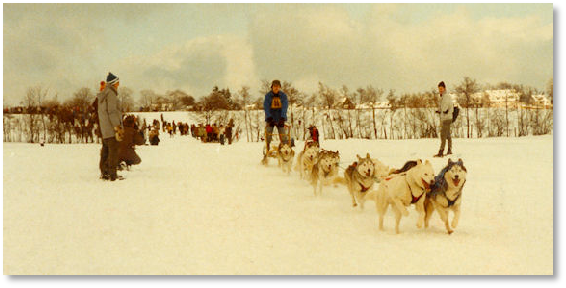
Axel’s winnende team in Winterbergrace
Axel’s team winning the Winterberg race
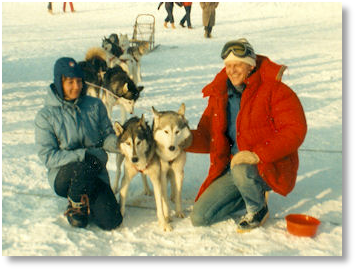
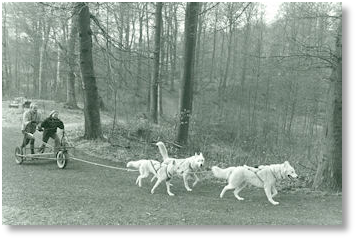
Axel en Liz met hun leidershonden
in de Winterbergrace
Axel and Liz with their lead dogs
in the Winterberg race
Axel’s eerste team met drie
Chuckchi Siberians
Axel’s first team with three
Chuckchi Siberians